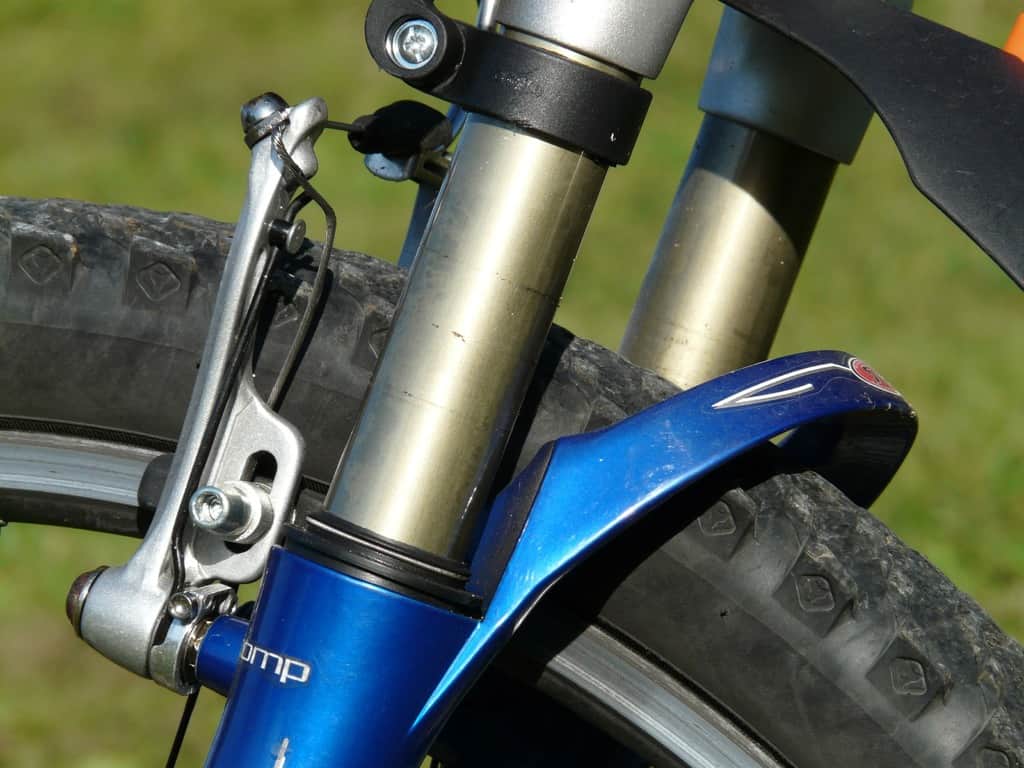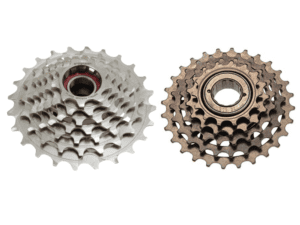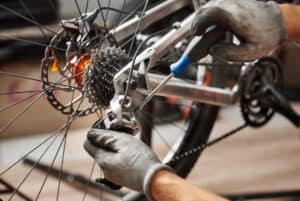Did you try yout best to repair your bent bike fork but to no good and now want to replace it with a new one? The good news is that you don’t need to head down to your local bike shop to change them.
Well, I’ll be showing you how it is done. It’ll involve a bit of elbow grease and exact size tools, but it’s an easy task to do.
How To Remove An Old Mountain Bike Fork?
These steps will be pretty much the same for any mountain bike, but the size of the tools may vary ( 4, 5, and 6mm hex wrenches).
I will point this out when there might be different sizes and where you might find the torque settings.
If you don’t own a torque wrench, you’re going to be okay – ensure you don’t overtighten things! Now, right, onto the steps.
Step 1: Stem Bolts
Start by loosening each stem bolt. Generally, there are two types; a 4mm hex head or a Torx head. Find the size you need and loosen them.
It’s worth alternating when you’re loosening them because it keeps things even as they become loose.
Step 2: Remove the Top Cap
Now, you’ll need to remove the top cap. You will need a 4 or 5mm hex head to do this.
There will be a bolt as you remove the top cap; remove that too. Keep these to one side.
Step 3: Remove Stem, Spacers, Headset Cover
Before you jump into this step, please take care as once these parts are removed, the fork is free. This means it could slide out, and you lose a few parts.
So when you are removing parts, it’s best to keep a hand on the frame to ensure nothing goes astray. The stem should slide off easily as the stem bolts have already been loosened.
Now you should remove spacers if there are any. It’s best to keep these in order as it makes reassembly easier. Once the spacers are removed, you can remove the headset cover.
Step 4: Remove the Fork
Now everything is loose. You will be able to slide the fork away from the frame and consider that job done!
How Do You Remove a Seized Fork?
The first thing to ascertain is what type of fork you’re trying to remove.
By this, I mean, is it a threaded headset or threadless? The answer to this will determine how we remove the seized fork.
Is My Bike Fork Threaded or Threadless?
Threaded forks are often found on more entry-level mountain bikes and road bikes or those that are older. These will be equipped with a threaded steerer tube.
When you look at your fork and see threads on it that the headset can be attached to, it means you have a threaded fork. You can insert threaded stems physically into the fork.
Inside the stem, there is a wedge. This compresses and keeps the fork in place.
Threadless forks are more likely to be found on modern bikes. It won’t surprise you that there aren’t any visible forks when you look. This means that your stem slides onto the fork easily.
How To Remove a Seized Threadless Fork
When your fork has become seized with a threadless headset, it is most likely that the split center ring cone has become stuck. You need to remove the top cap, stem, and washers.
Then grab a wooden block, pop it on top of the steerer, and tap the steerer and cone. The tapping should free up the cone, and the fork should be able to come out.
If the fork isn’t budging, try giving the steerer tube a gentle tap on the sides with a mallet. All of this should help to loosen the cone washer sufficiently so that you can remove the fork.
How to Remove a Seized Threaded Fork
When your fork is stuck with a threaded headset, it’s likely caused by corrosion, and the locknut won’t move.
Your best bet is to try and get some oil in there to loosen the locknut. This will also help to remove built-up corrosion.
This may not be a quick fix. If it doesn’t work straight away, I’d recommend that you leave the oil in there for a few days to do its magic.
After that, the fork should become unstuck – though it may take a bit of leverage.
How Do You Remove a Headset?

Headsets can have a pretty hard life, especially on the trail, as they are in the line of fire. It used to be that a headset replacement was something only the local bike shop guy or an experienced bike technician would do.
However, these days, it’s something you can do at home – if you know how! So to remove a headset, you’re going to need the following tools:
- Headset press
- Allen Key (5mm)
- Bike grease
- Headset cup remover
- Hammer
- Mallet
- Block of wood
- Flat blade screwdriver
- Torque wrench
Step 1:
If you have a work stand, then your life will be easier. If you don’t, I’m sorry, but you’re going to be spending some time on your knees!
The first step is to take the front wheel off. Following that, remove the front brake caliper and brake caliper bolts. Don’t forget to remove the hose guide too.
Step 2:
You need to remove the stem next. On some stems, there are two bolts. If yours is like this, then loosen each bolt at a quarter turn. I suggest doing this because it prevents potential damage and stops you from overloading a bolt.
The gear cables then need to be removed from their slotted stops. At this point, you should also unclip the rear brake mechanism from the frame. We do this so that the bars are kept clear of the headtube.
Step 3:
Hold onto the frame and remove the top cap. Then you should remove the stem and the loose handlebars together. Be sure not to pull the rear brake mechanism when doing this. At this point, you can remove the headset spacers and take out the fork.
If the fork is sticking, don’t be afraid to use a rubber mallet and a gentle tap on the end of the steerer to unstick it.
Step 4:
For those of you who don’t have a headset cup remover, you will have to improvise! This is fine as you’re removing the headset, so it’s probably already broken. I’m not saying you will damage it, but there’s a chance you might!
Take your hammer and a flat blade screwdriver. You can use these to tap out the headset cups.
You aim to remove the headset little by little. If you keep switching sides as you do this, it will come out quickly.
Step 5:
If you also don’t have a crown race removal tool, you will have to do a bit more improvising! With your fork upside down, ensure the steerer rests on the wooden block.
Take a flat-headed screwdriver and a hammer. Using the same technique as above, hit the crown race collar to make it pull away.
How Do You Remove a Steerer Tube From a Fork?
Replacing a steer tube can be done but requires a lot of effort and money on modern mountain bikes. Not something you’d want to try yourself.
If we’re talking about traditional brazed steel forks, replacing the steer tube is entirely possible.
It’s usually cheaper to replace the entire fork when you weigh up the cost of replacing a steer tube from an earlier model fork. Anything made can be remade if you’re willing to pay enough.
On traditionally built steel forks – brazed – replacing a steerer tube is possible.
Are Bike Forks Universal?
No, you will need a fork compatible with your head tube, steerer tube, and your wheel size. It isn’t just about matching the size; you also need to check how they bolt together.
You may have noticed that head tubes have increased in diameter over the years, too. Modern bikes tend to have 1 1/8″ head tubes, whereas older bikes were around the 1″ diameter.
I mention this because if your bike is older, you’re going to have to ensure that you find a compatible fork, which may take more time and research.
Another thing you have to consider is the geometry with forks, as they vary quite a lot.
You will find that forks are either intended for rigid hardtail frames or suspension frames, so you need to ensure you get the right one.





